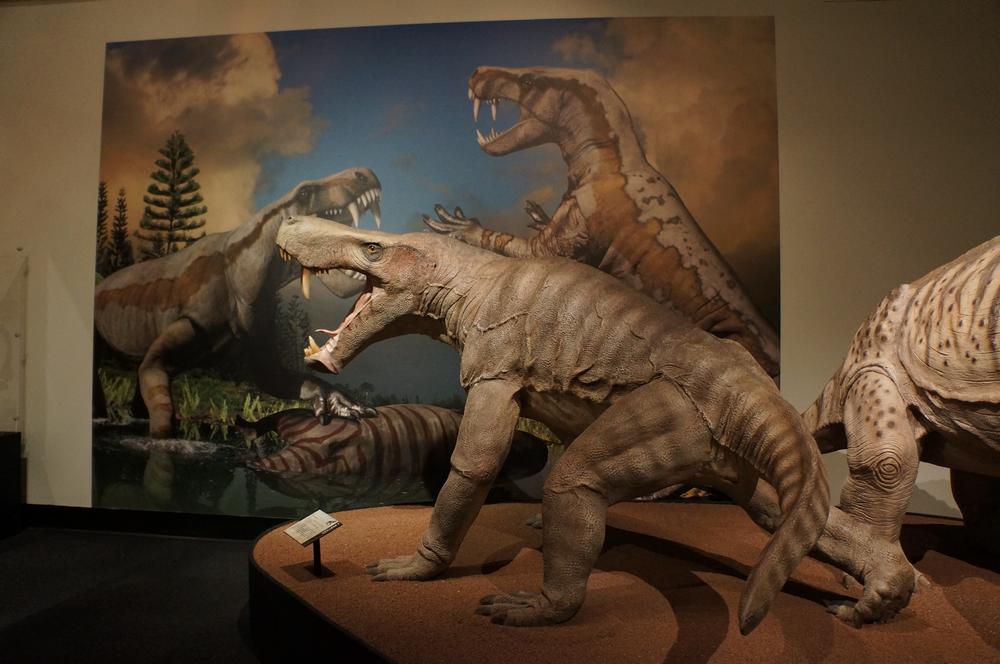The Permian Age was a time when giant insects and strange mammal-like creatures dominated a thin layer of seashore on the supercontinent of Pangaea.
The age ended with a greatest extinction on the planet with 95 percent of life going extinct.
The Sternberg Museum of Natural History will host the traveling exhibit “Permian Monsters: Life Before Dinosaurs” from May 27 through Labor Day.
Reese Barrick, Sternberg director, said the Permian age is one of his favorite geological time periods.
The 5 percent of the creatures and plants that survived the mass extinction are the precursors to what inhabits the planet today.
Giant dragon flies with four-foot wing spans ruled the air, amphibians trolled coastal areas and creatures that resemble today’s mammals were in abundance.
The exhibit presents the life of the Permian Age through multiple mediums, including artwork, fossils, animatronics and life-size models of these ancient creatures.
“It will show how they lived, how they evolved and how they died,” Barrick said.
He noted many of the creatures look odd compared to today’s amphibians, reptiles and mammals.
They had huge skulls and big arms one might think to hold up those large skulls. The creatures had more squatty back legs.
During this period, Kansas was under the ocean. As ocean water evaporated, it left large salt deposits as the ones that can be found in Hutchinson today.
Fossils consistent with those in the exhibit have been found in eastern Kansas, Texas and Oklahoma. Similar discoveries have been found in Russia.
The Appalachians were as high as the Himalayas, and South America and Africa were joined. One big ocean surrounded the giant continent, which means that circulation of the water was sluggish.
With one continent, there was a limited area of shallow coastline where life could thrive. Interior areas were dominated by desert.
The period was also a time of much volcanic activity. Volcanic eruptions extruded 10s of miles of lava and ash that might have changed the climate drastically.
In addition, methane had built up at the bottom of the oceans. Something may have happened to release the methane. The green house gas also could have significantly altered climate, resulting in the mass extinction.
Whether it was an asteroid or a drop in sea level that allowed the green house gases to escape, about 290 million years ago earth became a “bad place to live,” Barrick said.
“Without the Permian time and its increased level of oxygen, giant insects and the ancestors of mammals would have never existed,” he said. “Without the extinction, dinosaurs would have never evolved.”
The Permian Age has been well-studied, but it has not been well presented in museums, Barrick said.
The Permian Monsters exhibit was created in Australia. It has been in the U.S. only once before for a stop in Texas.
The Sternberg exhibition will be the first stop in the exhibit’s upcoming U.S. tour.
“It is a unique opportunity,” Barrick said. “Not everyone will get this traveling exhibit of these crazy looking animals that are pre-dinosaur.”
Admission to the exhibit will be included in the regular price of admission to the Sternberg. Admission costs are as follows: adults (age 13-59) $9, youths (age 4-12) $6, senior citizens (60+) $7, and FHSU students (w/valid ID) $5. For more information on the Sternberg click here.
Barrick said the Sternberg plans to have a special science day involving the exhibit, special events surrounding the sesquicentennial celebration and also a member’s only opening on May 26.










